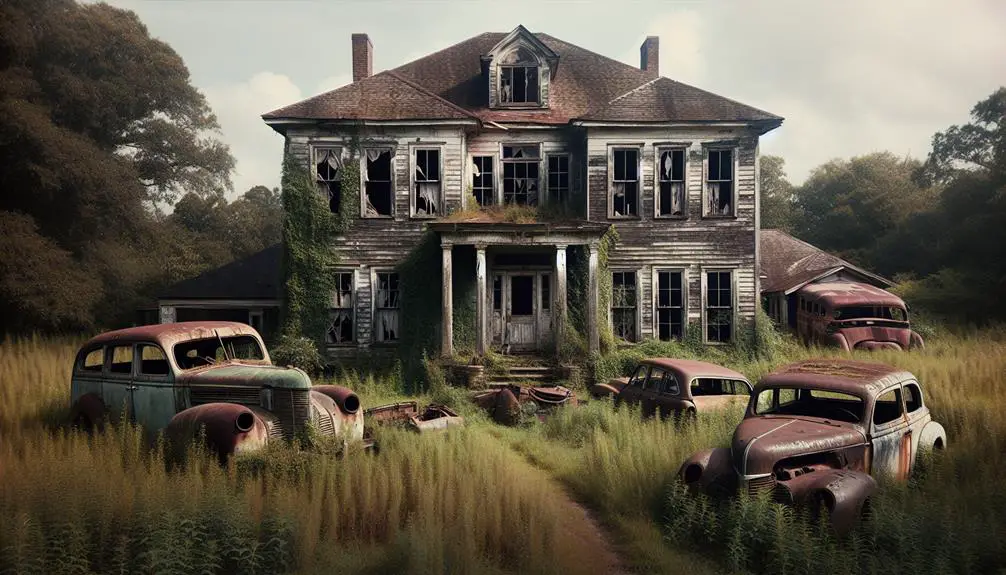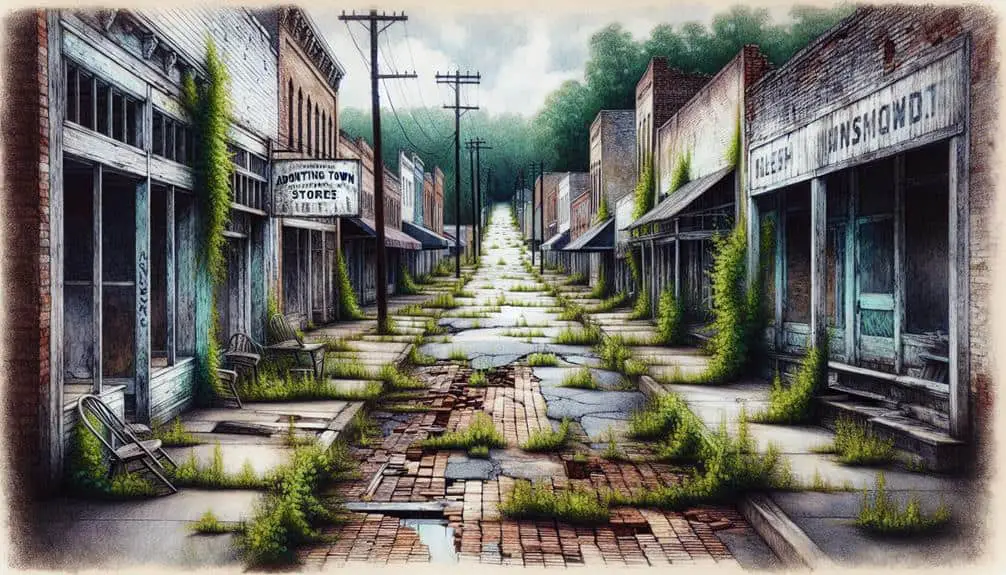To revive abandoned southern suburban communities, start with understanding historical significance. Recognize factors like economic decline and neglect. Engage the community in revitalization efforts. Prioritize mixed-use spaces and partnerships. Secure funding through grants and donations. Envision sustainable growth for restored neighborhoods. Each step in this guide is essential for successful restoration.
Key Points
- Implement strategic initiatives addressing economic decline and social migration challenges.
- Engage residents, businesses, and stakeholders in the revitalization process for community buy-in.
- Focus on mixed-use developments and green spaces to enhance livability.
- Seek government grants, donations, and collaborate with preservation groups for funding.
- Envision sustainable outcomes through economic growth, community resilience, and cultural diversity.
Historical Significance of Southern Ghost Towns
Exploring the historical significance of Southern ghost towns reveals a unique perspective on the region's past and cultural evolution. Many of these abandoned towns in the South can trace their decline back to the aftermath of the Civil War. The conflict left numerous communities devastated, leading to widespread urban decay as residents moved away in search of better opportunities.
The remnants of these ghost towns serve as poignant reminders of the impact of historical events on local populations. The once-thriving streets now lay silent, with crumbling buildings bearing witness to a bygone era. Understanding the history behind these abandoned settlements provides valuable insights into the challenges faced by Southern communities in the past.
Factors Contributing to Abandonment
Several key factors played a pivotal role in the abandonment of Southern ghost towns, shedding light on the complex circumstances that led to their decline. Economic decline and social migration were significant contributors to the desertion of these once-thriving communities. Understanding these factors is important in developing effective strategies for community revitalization.
- Economic Decline: Industries moving away from the area led to job losses and reduced economic opportunities, prompting residents to seek better prospects elsewhere.
- Social Migration: Changes in demographics and societal trends caused a shift in population dynamics, with younger generations moving to urban areas for education and employment.
- Infrastructure Neglect: Lack of maintenance and investment in essential infrastructure like roads, schools, and healthcare facilities made these towns less appealing for residents.
- Environmental Factors: Natural disasters, pollution, or other environmental challenges made living in these areas untenable, forcing people to abandon their homes in search of safer environments.
Steps for Community Revitalization
To revitalize Southern suburban communities, implementing strategic initiatives that address the root causes of abandonment is essential for fostering sustainable growth and prosperity. Community engagement plays a pivotal role in this process. Begin by involving residents, local businesses, and stakeholders in urban planning initiatives. Conduct surveys, hold town hall meetings, and establish community task forces to gather input and make sure that revitalization efforts align with the community's needs and aspirations.
Incorporating urban planning strategies is another vital step. Focus on creating mixed-use developments, improving transportation infrastructure, and enhancing green spaces. Revitalize abandoned properties by repurposing them for affordable housing or community centers. Embrace smart growth principles to guarantee that new developments are environmentally sustainable and socially inclusive.
Moreover, prioritize economic development by attracting businesses, creating job opportunities, and supporting entrepreneurship. Encourage public-private partnerships to leverage resources effectively. By fostering a sense of ownership and pride within the community, you can create a sustainable foundation for revitalization. Remember, community engagement and thoughtful urban planning are key ingredients in the recipe for successfully restoring Southern suburban communities.
Funding and Resources for Restoration
Securing adequate funding and leveraging available resources are vital components in the process of restoring Southern suburban communities. To guarantee successful restoration efforts, it's essential to explore various avenues for financial support and engage the community in preservation initiatives.
Here are four key strategies to ponder:
- Seek Financial Support: Look into government grants, private donations, and crowdfunding platforms to secure the necessary funds for restoration projects. Tap into available resources to maximize financial assistance opportunities.
- Utilize Grant Opportunities: Research and apply for grants specifically tailored to community revitalization and historic preservation. These grants can provide significant financial aid to support your restoration endeavors.
- Engage the Community: Foster community engagement by involving residents, local businesses, and organizations in the restoration process. Encouraging active participation can't only enhance the sense of ownership but also attract additional support and resources.
- Collaborate for Resources: Partner with local preservation groups, historical societies, and other stakeholders to access shared resources, expertise, and networks. Collaborative efforts can amplify the impact of restoration initiatives and create a sustainable framework for long-term success.
Future Prospects for Restored Communities
As you look ahead to the future prospects for restored Southern suburban communities, envision sustainable outcomes that embrace community resilience and cultural preservation. Vital growth is an important aspect of the future of these communities. By fostering local businesses, creating job opportunities, and attracting investments, restored suburbs can experience a revitalization that benefits all residents.
Encouraging community engagement plays a significant role in ensuring the success and longevity of these neighborhoods. Empowering residents to participate in decision-making processes, organizing events that bring people together, and establishing support networks are essential for fostering a sense of belonging and pride within the community.
Furthermore, the future prospects for restored Southern suburban communities rely heavily on strategic planning and collaboration between residents, local authorities, and organizations. Implementing sustainable practices, preserving historical landmarks, and promoting cultural diversity are key factors that contribute to the overall well-being and attractiveness of these neighborhoods. By focusing on economic growth and community engagement, restored communities can thrive and become vibrant, self-sustaining hubs for future generations.
Frequently Asked Questions
Can Abandoned Southern Suburban Communities Be Converted Into Sustainable Eco-Friendly Developments?
Yes, abandoned southern suburban communities can transform into sustainable eco-friendly developments. By implementing sustainable design principles and green infrastructure, these areas can flourish. You have the power to revitalize these communities for a brighter future.
How Can Local Governments Support the Revitalization Efforts of Abandoned Communities?
To support revitalization efforts in abandoned communities, local governments can foster public-private partnerships to leverage resources effectively. By tapping into diverse funding sources, such as grants and tax incentives, they can drive sustainable development and community renewal.
Are There Any Success Stories of Abandoned Communities Being Restored and Thriving Once Again?
You might find irony in the success stories of urban renewal in abandoned communities. The economic impact is profound, showcasing resilience and ingenuity. Witnessing these transformations firsthand can inspire change and hope for the future.
What Role Can Community Engagement and Involvement Play in the Restoration Process?
Engaging with your community through collaboration and grassroots initiatives can be pivotal in restoring abandoned areas. By involving residents in decision-making and fostering a sense of ownership, you can revitalize neighborhoods together.
What Are Some Potential Challenges or Obstacles That May Arise During the Restoration of Abandoned Southern Suburban Communities?
Facing potential challenges during restoration includes funding hurdles for revitalization projects and infrastructure barriers like outdated utilities. Community resistance and environmental concerns can impede progress, necessitating strategic planning and collaborative solutions for successful restoration.



